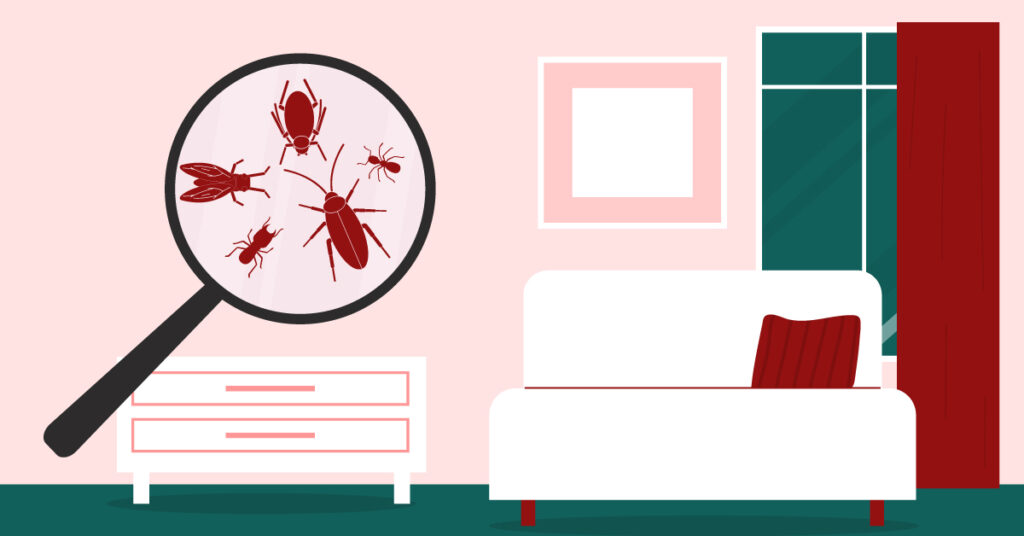Keeping bugs and critters at bay is part of owning a home. We all try the occasional DIY fix: a spray here, a trap there, and sometimes that’s enough for a minor nuisance.
But what about those times it’s not enough?
Knowing when to throw in the towel and call a professional pest control service can save you money, time, and a lot of frustration. In this post, we’ll cover clear signs that DIY methods won’t cut it, look at common pest problems by region across the U.S., compare the short-term vs. long-term consequences of ignoring infestations, highlight red-flag signs of pests you should never ignore, discuss why hiring a pro has big advantages, and offer tips on choosing a reputable pest control company.
When DIY Pest Control Isn’t Enough
Most homeowners can handle the occasional ant trail or lone wasp. However, there are certain pest situations where calling a professional is the safest and most effective course of action. Here are some clear indicators that DIY pest control isn’t enough:
Termites and Other Wood-Destroying Insects
If you suspect termites, don’t attempt to handle them alone. Termites wreak havoc, causing over $5 billion in property damage each year by continuously chewing through wood. Homeowners’ insurance typically does not cover the damage they cause. Carpenter ants, carpenter bees, or powderpost beetles can also quietly hollow out wood beams over time. A professional can effectively eliminate these pests before they compromise your home’s structural integrity.
Bed Bug Infestations
Bed bugs are notoriously difficult to eradicate. They hide in tiny cracks and crevices, laying eggs that DIY sprays often miss. Attempting to control a bed bug problem on your own can exacerbate the issue, allowing the infestation to grow. In fact, a single female can lay up to 500 eggs during her lifetime, so that a small problem can explode quickly. Professionals have the specialized treatments needed to eliminate bed bugs at all life stages.
Stinging Insect Nests
A single yellow jacket in the house is one thing; a large wasp or hornet nest on your property is another. Hornets, yellowjackets, wasps, or fire ants can form huge colonies (sometimes comprising tens of thousands of insects) that will attack in force if disturbed. These pests send about 500,000 people to the ER every year due to stings. If you find a nest of stinging insects, especially if anyone in your family has allergies, call a pro to remove it safely.
Heavy or Recurring Infestations
Seeing the same pests return repeatedly, despite your best DIY efforts, is a clear indication that you need professional help. If an infestation keeps recurring despite your efforts, it’s time to contact a professional pest control company. Similarly, if you’re facing a large infestation (e.g., cockroaches in every room or mice in multiple walls), DIY methods are unlikely to eliminate it. Professionals can identify hidden entry points or nesting sites and eliminate the root cause of the problem.
In short, trust your gut. If a pest problem seems beyond a quick fix, due to its size, danger, or persistence, hiring a pro is usually the best choice.
Regional Pest Problems Across the U.S.
Pest issues can vary a lot depending on where you live. The United States has a range of climates, and each region comes with its own resident “critters” that tend to cause the most headaches for homeowners. Below is a quick regional breakdown of common pest problems:
Southeast: Termites and Humidity-Loving Pests
The warm, humid conditions in the Southeast (think Florida, Georgia, the Carolinas, etc.) are a paradise for termites. These states experience some of the heaviest termite activity in the country. Subterranean termites, in particular, thrive in moist soil and can quietly consume a house’s wooden framework if not kept in check. Homeowners in the Southeast often invest in regular termite inspections, since an untreated infestation can cause severe structural damage.
The Southeast’s climate also invites other unwelcome guests, including cockroaches (which thrive in moist and warm environments), fire ants in yards, and an abundance of mosquitoes in the summer. If you live in this region, staying proactive about pest control and knowing when to call a pro is especially important.
Northeast: Rodents in Cold Climates
Up in the Northeast (from New England down through, say, Pennsylvania), cold winters drive mice and rats to seek cozy indoor shelter. It’s common for folks in these states to start hearing scurrying in the walls or find droppings in the basement as soon as the first frost hits. Rodents will sneak into basements, attics, and wall voids to ride out the winter, often stockpiling food in hidden nests.
Older cities in the Northeast (looking at you, New York and Boston) are also notorious for rat problems year-round, given the dense population and endless food sources. While you might catch the occasional mouse with a snap trap, a serious rodent issue in this region is best handled by a professional who can seal entry points and safely remove or bait the pests. Aside from rodents, the Northeast can experience invasions of cluster flies and stink bugs in homes during autumn. Some areas have bed bug flare-ups – another pest scenario that typically requires the assistance of an exterminator.
Midwest: Seasonal Invaders and Summer Swarms
The Midwest has a diverse range of pests, but many of its pest problems are seasonal in nature. In the summer months, the heat and humidity (especially around the Great Lakes and the Mississippi River) create ideal breeding conditions for mosquitoes, which are not only annoying but can also transmit diseases like West Nile or Zika. Come late summer and fall, many Midwestern homeowners start to see insects like boxelder bugs, Asian lady beetles, or stink bugs clustering on the sunny sides of houses; these pests try to sneak indoors to overwinter once the weather cools.
Similarly, in the Northeast, when winter arrives, mice may move into garages or between walls to stay warm. Farms and grain storage in rural areas can attract their own set of pests (like grain beetles or field mice). The good news is that many Midwest pest issues are merely nuisance invaders. However, if you suddenly find your porch covered in wasps or your attic taken over by squirrels, it may be time to bring in a professional who knows local pest behavior.
Southwest: Scorpions and Desert Pests
In the arid Southwest (Arizona, New Mexico, Nevada, and parts of southern California and Texas), scorpions are a well-known pest concern. There are about 70 scorpion species in the U.S., but thankfully, only one, the Arizona bark scorpion, has venom potent enough to be dangerous to humans. If you’re in the Phoenix or Las Vegas suburbs, for example, it’s not unheard of to find a small scorpion in your shoes or bathtub (yikes!).
These nocturnal arachnids sneak into homes through tiny gaps, seeking water and cool shelter from the desert heat. While many scorpion stings are about as painful as a wasp sting, a bark scorpion sting can cause severe symptoms, making professional extermination a wise choice. The Southwest’s dry climate also means residents deal with other desert-adapted pests – such as black widow spiders, tarantulas, or pack rats that chew on car wiring. Scorpions, however, remain the poster child pest of this region, and local pest control professionals are well-versed in evicting them.
Pacific Northwest: Spiders and Moisture-Loving Bugs
The Pacific Northwest (Washington, Oregon, and parts of Northern California) is known for its lush greenery and… a lot of rain. That damp climate attracts pests that thrive in moist environments. A big one is spiders – the cooler fall weather in the Northwest drives spiders indoors in search of dry, warm spots. The good news is that nearly all house spiders in this region are harmless to humans and even prey on other pests. Still, many people aren’t thrilled to share their home with them. You may notice an increase in spiders in garages, basements, or ceiling corners as the rainy season approaches.
The Northwest’s wet wood can also attract carpenter ants (which chew water-damaged wood) and slugs or other ground crawlers sneaking into ground-level floors. Overall, Pacific Northwesterners don’t face as many indoor infestations as some other regions. Still, if you suddenly see lots of spiders or discover wood damage from moisture ants, it’s time to get a professional assessment. Often, a combo of fixing moisture issues and targeted treatment does the trick in this region.
Short-Term vs. Long-Term Consequences of Ignoring Infestations

It’s tempting to ignore a few pests and hope they just go away. In the short term, that might seem to work – you might only experience minor annoyances. For example, ignoring a small ant problem might only mean a few ruined cereal boxes or some ants in the dishwasher. A lone mouse in the garage might not bother you much at first, aside from the occasional squeak or gnawed box. In the short run, the consequences of low-level pest activity are often things like unpleasant odors (a whiff of mouse urine here, a whiff of a dead roach there), a bit of mess or damage (chewed crumbs, some sawdust), or mild sleep disturbance (those 2 a.m. mosquito whines in your ear). Nothing life-changing, right?
However, pests rarely solve themselves – and an infestation left unchecked can snowball into a serious problem. Over the long term, ignoring pests can have catastrophic consequences for your home and even your health. Termites are a prime example: they work silently and relentlessly, and a colony chewing unnoticed can compromise the structural stability of your home in a matter of months. These wood-destroying organisms cause billions of dollars in damage annually, and homeowners often only realize there’s a problem once significant harm has been done. Most insurance policies don’t cover termite damage, so those repair costs come out of pocket. And it’s not just termites — consider rodents: if rats or mice are allowed to breed in your attic or walls, they won’t just multiply, they’ll gnaw on everything.
Rodents chewing on electrical wires can create a significant fire hazard; in fact, it’s estimated that rodents are responsible for up to 20% of undetermined house fires in the U.S. (due to their chewing through wiring). Roaches and rodents also spread diseases and trigger allergies with their droppings. What started as a few roaches can turn into a massive infestation that taints your food and surfaces with bacteria. A couple of mice can multiply into dozens, posing risks of fires, contamination, and illness. The bottom line: the longer you ignore an infestation, the more damage (and expense) you’re likely to incur. Small pest issues rarely stay small, so early action , often calling a professional, is key to avoiding long-term fallout.
Signs of Infestation You Should Never Ignore
How do you know you might have a growing pest problem on your hands? Some signs are subtle, others smack you in the face (sometimes literally, in the case of a flying cockroach!). Here are a few red-flag indicators of an infestation that you should never ignore:
- Pest droppings: Mysterious little pellets or dark specks around the house are often the first clue of pests. Rodent droppings are similar looking to black grains of rice, while cockroach droppings can resemble coffee grounds or black pepper. If you start noticing any unexplained droppings in cabinets, along baseboards, or in the back of drawers, don’t shrug it off.
- Gnaw marks or wood damage: Any unexplained damage to your home’s materials could be a sign of pest activity. Chewed wires, holes gnawed in food packaging, or bite marks on wood trim indicate the presence of rodents. Similarly, wood shavings or sawdust-like frass near wooden structures can indicate that termites or carpenter ants are tunneling inside. If your baseboards or furniture legs have tiny chew marks, or you find pencil-sized holes in wood beams, something is feasting on your house – time to call a pro.
- Strange sounds (especially at night): Ever lie in bed and hear scratching or scurrying in the walls or above the ceiling? Those unexplained noises at night strongly suggest rodents are active when the house is quiet. Rats and mice make scratching sounds as they climb and chew, and you might even hear faint squeaks or movement. Insects can make noises too – large cockroaches may rustle papers, and termites click their jaws or heads when disturbed. If you’re consistently hearing ticks, taps, or scrapes in the walls at night, don’t ignore them.
- Unpleasant or musty odors: A persistently funky smell can be a sign of pests, even if you don’t see them. For example, a heavy, musty odor in a room could mean a serious roach infestation (they produce an oily, musky smell). A sharp ammonia-like smell often signals a build-up of rodent urine and droppings. And of course, the stench of something decaying (ugh) might mean a mouse or other critter died in a hidden spot. If your nose detects a weird smell that cleaning doesn’t solve, consider that pests might be the cause.
- Nesting evidence: Pests often leave behind evidence of their comfy little homes. Finding shredded paper, torn fabrics, or insulation fluff tucked away in drawers, boxes, or attics is a classic sign of rodents building nests. Insects leave clues, too: discarded insect wings (for instance, after termites swarm, you’ll find piles of tiny wings), egg cases or shells, or shed exoskeletons from molting bugs. Any accumulation of such debris means something is living (and reproducing) in your house. Don’t ignore piles of what looks like sawdust, bits of grass or leaves indoors, or mysterious spiderweb-like materials in corners.
- Frequent sightings of pests (alive or dead): Perhaps the most obvious sign: you keep seeing the critters. One cockroach skittering across the counter might be a fluke, but if you start seeing roaches regularly, especially during the daytime, that indicates a significant hidden population. Likewise, spotting multiple ants every day or a stream of them on your floors means a nearby colony is thriving.
Advantages of Hiring a Professional Pest Control Service
So, you’ve seen the signs and you know DIY sprays or traps aren’t going to cut it. What exactly are the benefits of calling in a professional exterminator? Here are some significant advantages of hiring a pro:
Safety and Peace Of Mind
Professional pest technicians are trained and certified in the safe handling of pesticides and pest removal techniques. They know how to target pests without compromising your family’s health. By contrast, DIY pest control can expose you to chemicals or risky situations (climbing in attics, dealing with wasp nests, etc.). In extreme cases, homeowners attempting to treat pests themselves have damaged their homes or sickened their families by misusing pest control products. A pro will use the right chemicals in the right places, in safe amounts, significantly reducing any hazard to you, your kids, or your pets.
Expertise and Thoroughness
Identifying the exact pest species and the extent of an infestation can be tricky. Professionals do this every day – they can tell a termite from an ant, a Norwegian rat from a roof rat, and they know all the hiding spots. This expertise means they won’t just treat the pests you see, but also the ones you don’t see(inside walls, in crawl spaces, etc.). They can locate nests, entry points, and conditions attracting the pests. DIY approaches often miss these root causes. A good exterminator will also provide a game plan to address underlying issues (e.g., advising on sealing cracks or removing moisture sources) so that the problem doesn’t recur. It’s a level of thoroughness that store-bought solutions typically can’t provide.
Long-Term Cost Savings
While a professional service has an upfront cost, it can actually save you money in the long run. Why? Because an expert will truly solve the problem, whereas many DIY efforts only deliver temporary relief. If you repeatedly re-spray, those costs add up – and in the meantime, the infestation could be causing expensive damage. Professionals eliminate pests more effectively, preventing extensive property damage and the need for continuous retreatments. Stopping termites early, for example, might save you from paying for major wood repairs later. Many people who try multiple DIY fixes eventually end up calling a pro anyway; going to the experts first can spare you those repeated expenses (and a lot of frustration!).
Time and Convenience
Let’s face it, tracking down elusive pests and deploying traps all over your home is not how most of us want to spend our weekends. Hiring a pro means you get quick, efficient results without the hassle on your part. Pest technicians have access to better equipment and products, so they can often treat a home in a fraction of the time it would take you, even to determine where to apply the spray. You don’t have to research what bait to buy or worry if you mixed the pesticide correctly – they’ve got it covered. This lets you get back to enjoying your home rather than stalking bugs around the kitchen at midnight.
Follow-Up and Prevention
Many professional pest control services offer guarantees or follow-up visits as part of their treatment plan. If the pests return, so do they (at no additional charge) until the issue is resolved. This kind of guarantee gives you confidence that the problem will be taken care of.
Tips for Selecting a Reputable Pest Control Service
Once you’ve decided to hire a professional, the next step is finding the right company for the job. Not all exterminators are created equal! You want someone competent, honest, and effective.
Here are some tips to help you choose a reputable pest control service:
- Verify licensing and certification: This is non-negotiable – make sure any pest control company you consider is properly licensed to operate in your state. Ask if the technicians who will be performing the service are certified and licensed applicators.
- Check reputation and references: Start by asking friends, neighbors, or your community on social media if they have recommendations – first-hand experience is gold. Also, look at online reviews (keeping in mind that no company pleases everyone 100% of the time, but overall trends matter). Feel free to ask the company for references from past customers as well.
- Look for professional affiliations: Membership in industry associations can be a positive sign. Companies that are members of the National Pest Management Association (NPMA) or state and local pest control associations show a commitment to staying up-to-date on best practices.
- Compare value (not just price): It’s wise to get a few quotes from different companies – but be careful of just choosing the lowest bid. Price matters, but you want quality and competence in something as important as pest control.
- Understand the treatment plan and guarantees: A trustworthy pest control pro will take the time to inspect your home and explain their recommended treatment strategy. Before you sign anything, ensure you fully understand what pests are covered, the treatments that will be applied, and any guarantees provided.
- Watch out for red flags: Unfortunately, like any industry, pest control has its share of bad actors. Be cautious of companies that use high-pressure sales or scare tactics. For instance, no legitimate exterminator should claim something outrageous, such as “your house will collapse in a week if you don’t buy our treatment today!”
By conducting some due diligence, you can find a pest control partner that will effectively and safely resolve your pest issues. The goal is to eliminate the pests and have peace of mind about the process.
You might also be interested in: 9 Effective Strategies for Controlling Rodent Populations




